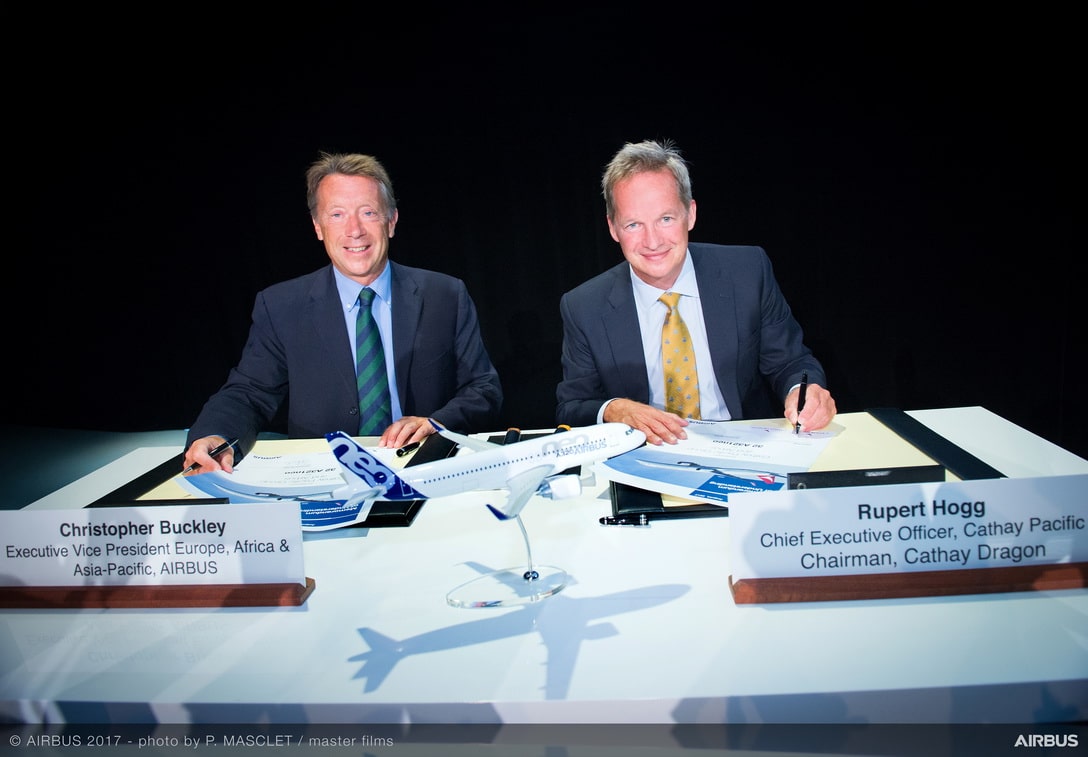Aviation
Cathay Pacific Group signs MOU for 32 A321neo aircraft

Toulouse, 21st August 2017– Cathay Pacific Group has signed a Memorandum of Understanding (MOU) with Airbus for 32 A321neo single-aisle aircraft. The aircraft will be operated by Cathay Dragon, the regional carrier of the Group, on services linking its Hong Kong home base with destinations across Asia.
The new A321neo aircraft will replace and modernise Cathay Dragon’s current in-service fleet of 15 A320s and eight A321s, with the additional aircraft allowing the airline to capture growth opportunities in the region. The Cathay Dragon network currently covers 56 Asian destinations, including 28 in mainland China.
Cathay Pacific Chief Executive Officer and Cathay Dragon Chairman Rupert Hogg said: “The Airbus fleet has been serving Cathay Dragon well over the decades. With the A321neo we expect to benefit from a very significant increase in operating efficiency, while increasing capacity in the Cathay Dragon network in order to expand our reach to more customers.”
He added: “The intention to purchase these 32 environmentally-friendly aircraft will allow us to add new destinations to Cathay Dragon’s network, increase frequency on some of our most popular routes and expand our network in the region in order to provide more travel choices and convenience to our customers.”
John Leahy, Airbus Chief Operating Officer, Customers said: “Airbus is proud to have been selected to supply Cathay Dragon’s future single-aisle fleet. This is another major endorsement of the A321neo as the aircraft of choice in the middle-of-the-market segment.”
Airbus delivers its first aircraft produced in the USA.(Opens in a new browser tab)
“The A321neo offers the lowest operating costs, longest range capability and most spacious cabin in its class. It will be the perfect aircraft for Cathay Dragon as it builds on its success as one of Asia’s leading regional carriers.”
Cathay Dragon is an all Airbus operator, with a current fleet of 23 A320 Family aircraft and 24 widebody A330-300s. In addition, Cathay Pacific operates 37 A330-300s, making the Group the largest A330 operator in the Asia-Pacific region. Cathay Pacific also operates the all-new long haul A350 XWB, with 17 A350-900s already in service. The carrier has another 31 A350 XWBs on order for future delivery, including the A350-900 and larger A350-1000.
The A321 is the largest member of the A320 Family and seats up to 240 passengers, depending on cabin configuration. Incorporating the latest engines, aerodynamic advances and cabin innovations, the A321neo offers a reduction in fuel consumption of up to 20 per cent per seat and can fly up to 4,000 nautical miles (7,400 kilometres) non-stop – further than any other single-aisle airliner.
The A320 Family is the world’s best-selling single-aisle product line and comprises four models (A318, A319, A320, A321) seating from 100 to 240 seats. To date, the Family has won over 13,200 orders and more than 7,700 aircraft have been delivered to some 400 customers and operators worldwide.

Aviation
Airbus Enhances A350 Cabin with 10-Abreast Seating

Airbus has announced a new partnership with Jiatai Aircraft Equipment, a Chinese aircraft seating manufacturer, to supply upgraded economy-class seats for the A350 widebody series.
This collaboration, unveiled at the 2024 Airshow China, focuses on developing a newly designed economy seat tailored for the A350‘s New Production Standard (NPS) cabin.
One of the key features of the NPS cabin is the ability to accommodate 17-inch wide economy seats, compared to the previous 16.5-inch wide seats that airlines were limited to in the A350’s earlier configurations.
British Airways Unveils Its Brand-New First Class Cabin for the Airbus A380
This change is made possible by the expanded space in the NPS cabin, which is 35 inches longer and 4 inches wider than the previous version. This extra space is achieved by slightly moving the cockpit wall forward and shifting the rear pressure bulkhead back by one frame.
The wider cabin allows airlines to add up to 30 extra economy seats without compromising comfort. For airlines opting for a 3-4-3 seating layout, the 17-inch wide seats are an excellent choice for a more comfortable passenger experience. However, some airlines, such as Iberia, may choose to retain a 9-abreast layout with wider seats for added comfort.
The NPS cabin also offers enhanced flexibility for airline operators. One major advantage is the ability to easily switch between a 9-abreast and 10-abreast seating configuration without requiring significant downtime for aircraft reconfiguration. Airlines can use the same seat rails, tracks, and IFE interfaces, making the transition smoother and quicker.
Etihad Airways Unveils 10 Exciting New Routes for 2025
In addition, the design of the floor attachments and air-conditioning systems has been optimized for 10-abreast seating, meaning airlines can upgrade their cabins without needing to make substantial modifications to the aircraft’s structure.
Though it’s still unclear when Jiatai’s economy-class seats will be officially added to the A350’s Buyer Furnished Equipment (BFE) catalogue, the collaboration marks a significant step toward enhancing the A350’s cabin offerings.
With this partnership, Airbus is providing more seating options for airlines, ensuring that they can meet diverse customer needs while improving overall operational efficiency.
-

 Aviation2 months ago
Aviation2 months agoMicrosoft Flight Simulator Raises $3 Million to Bring Back the An-225 Mriya
-

 Airlines2 months ago
Airlines2 months agoQatar Citizens Can Travel to the United States Without a Visa
-

 Aviation2 months ago
Aviation2 months agoQatar Airways bans these new Electronic Devices on plane
-

 Airlines2 months ago
Airlines2 months agoJapan Airlines Rolls Out Free Domestic Flights to International Passengers
-

 Defence2 months ago
Defence2 months agoWhich Country Has the Largest Fleet of Fighter Aircraft?
-

 Airport2 months ago
Airport2 months agoWestern Sydney Airport Welcomes Its First Plane After 6 Years of construction
-

 Airlines4 days ago
Airlines4 days agoDAMAC Air: Dubai’s New Luxury Airline Offers Free Flights for Registration
-

 Aviation2 months ago
Aviation2 months agoDid you know ? Once Boeing 747 carried 1088 passenger in 1991








